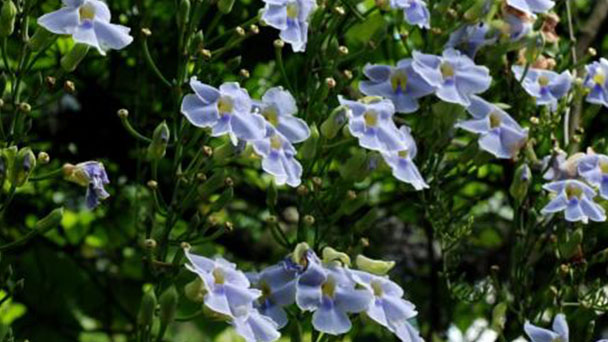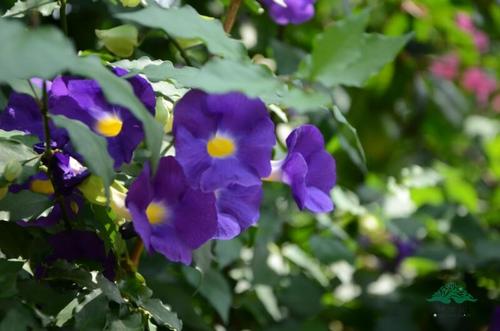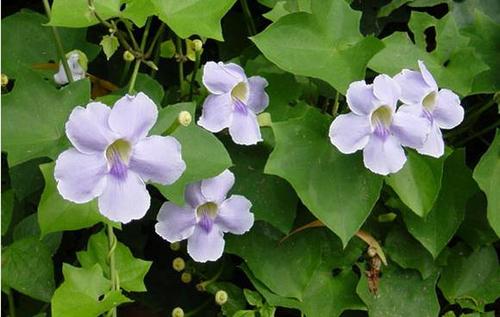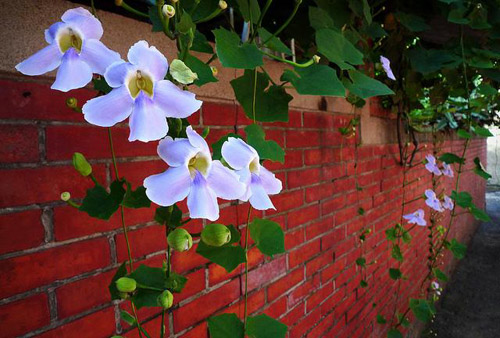Bengal trumpet (Thunbergia grandiflora) profile
Written by admin
Mar 05 2021

Bengal Trumpet, scientific name Thunbergia grandiflora, also called Bengal clockvine, Bengal trumpet, blue skyflower, blue thunbergia, blue trumpetvine, clockvine, skyflower and skyvine, is a large coarse-shaped woody vine that can reach up to 7 m in height. Bengal trumpet likes sunshine, moist soil, good drainage shelter. It can also be used as an ornamental plant.
Bengal trumpet picture

Morphological characteristics of a Bengal Trumpet
Stems
The stem of Bengal Trumpet was stout and over 7rn long, and the whole plant was densely covered with coarse hair.
Leaf
Leaves of Bengal trumpet are thick, simple, opposite, 12 -- 18cln long, broadly ovate, with 3 -- 5 palmately veined, similar to melon leaves, leaf margin angular or lobed, petiole wingless.
Flowers
The flowers of a Bengal trumpet are large, axillary, stalked, many solitary, pendulous racemes, corolla 5 -- 8cm long and 7cm diameter;Leaf-shaped bracts 2, connate at first, posterior side dehiscence into Buddha flame bracts, with hairs; Calyx is degenerated, corolla funnelform, blue flowers at the beginning, light blue flowers, nearly white flowers at the end.
Fruit
Capsule of a Bengal trumpet subglobose lower part, with a long beak upper part, descending like a crow's beak.
Ecological habits of Bengal Trumpet
Bengal trumpet prefers warm, moist and sunny environments, not cold, but slightly shade-tolerant, but prefer well drained, moist, sandy loam. The optimum temperature for growth is 15~30℃, and the growth stops below 8℃. Bengal trumpet climbs by twining the stem and grows fast, with an annual growth of more than 4m. It has strong branching capacity and few diseases and insect pests.
Bengal trumpet propagation
Bengal trumpet propagates by cuttings. Cutting propagation pots should be planted with support or suspension cultivation. The flowers are numerous and brightly colored.
How to grow and care for Bengal Trumpet
Water
Bengal Trumpet likes a wet environment and should be watered according to the principle of "When wet, when dry, thoroughly watered". That is to dry can be watered, remember not to water.
Fertilizer
As a matter of fact, a large quantity of fertilizer is required by a Bengal Trumpet. The principle of "frequent application of thin fertilizer" is generally followed, and should be applied every 2 weeks during the growing season.
Soil
Bengal trumpet is well adapted to the soil and prefers to grow in a loose, fertile, breathable sandy loam with good drainage.
Repotting
Usually, a Bengal Trumpet is replaced biannually for the larger pot and annually in the spring for the smaller pot. Remove part of the old and over-long root system and remove the old soil to replace it with new culture soil for a Bengal Trumpet to bloom.
Environment
Bengal Trumpet likes to grow in a sunny and well-ventilated environment. The daily sunshine is not less than 4 hours, it is best to keep full sunshine.
Temperature
The optimum temperature for the growth of Bengal Trumpet is generally between 18 and 28 ° C. The temperature should not be lower than 10℃.

The distribution area of Bengal Trumpet
Bengal Trumpet is native to Bangladesh, Thailand, India, and China. It is widely distributed in tropical and subtropical regions.
Bengal trumpet uses
Medicinal value
The whole plant has medicinal value. The root skin of a Bengal Trumpet can be used for injuries caused by falls, fractures, menstrual abdominal pain, strain of the lumbar muscles, swelling, toxin extraction, drainage and muscle production, and gunshot injuries.
Landscape use of Bengal Trumpet
Bengal trumpet has a stout plant with a large covering area and large and dense flowers that hang down in clusters for a long period of time. It is suitable for use on large trellages, middle-rise buildings, hedges, as well as on urban castles, overpasses, etc. Bengal trumpet can not only quickly cover the building to form a green barrier, but also the unique flowers can be added to the surrounding environment, forming a beautiful landscape line in the three-dimensional greening.
Bengal Trumpet similar species
Thunbergia grandiflora is not similar, but is related to other Thunbergia species among them Thunbergia alata (black-eyed Susan), Thunbergia battiscombei and Thunbergia fasciculata.
Bengal Trumpet is also similar to Thunbergia laurifolia (laurel clock vine) and quite similar to Thunbergia fragrans (fragrant thunbergia) and Thunbergia arnhemica all of which are exotic to the region.
T. grandiflora can be more easily distinguished from T. alata by the conspicuous yellow flowers which are much smaller.

Latest Updated
- Benefits of Bugleweed - 7 Science-backed Health Benefits
- Bugleweed Dangers & Side Effects - Is It Poisonous?
- How to Plant Evergreen Trees - What You Should Know
- When to Plant Evergreens - Grow Guide for Evergreen Trees
- 12 Wonderful Evergreen Shrubs for Your Garden
- 12 Popular Evergreen Plants with Pictures for Beginners
- When And How To Prune A Lilac Bush Like a Pro
- How to Grow & Care for Lilac Vine (Hardenbergia Violacea)
- Japanese Lilac Tree (Syringa Reticulata) Care & Propagation Guide
- Shumard Oak Pros and Cons - What to Know
Popular Articles
- Winter maintenance of Antirrhinum Majus
- How to Grow Terminalia Mantaly Tree
- How to Grow and Care for Crossostephium Chinense
- How to grow Antirrhinum Majus in spring
- Peristeria Elata (Dove Orchid) Profile: Info & Care Guide
- Underwatered Snake Plant (Sansevieria Trifasciata) - Signs And How To Fix
- How to Care for Brazilian Jasmine Plant (Mandevilla Sanderi)
- How to Grow & Care for Graptopetalum Purple Delight in Summer
- Rosa Chinensis (China Rose): Plant Growing & Care Tips
- How to Care for Baby Sun Rose (Aptenia Cordifolia)